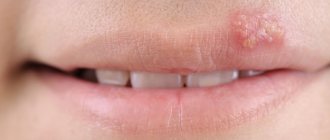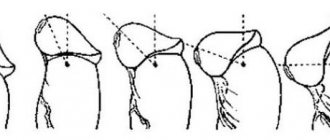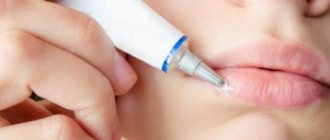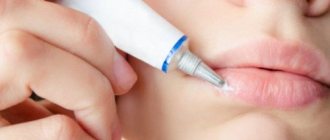Viruses are around us. Some of them suddenly appear and paralyze the normal life of the entire planet, others have been known for a long time, exist everywhere, often even are in the human body, but do not manifest themselves. The second option is the herpes virus.
Currently, 8 types are known, and the human body reacts differently to each of them. Some cause shingles or chickenpox, and only the first two appear less severely, most often just as “blisters” on the lips [1].
This disease was mentioned in literary works and historical documents 2000 years ago. But it was only in the 40s of the last century that the human herpes simplex virus was discovered, studied and described.
WHO indicates that in 2012, the number of people infected with the first type of virus alone was about 3.7 billion. At that time, 67% of the world's population was infected with it. The spread of this virus is trending to increase. Many people carry herpes and don't even know it [2].
Another problem is the high infection rate of the healthy population, mainly young, working age.
In the world, from 16 to 800 people are infected annually, and in Russia from 40 to 80 people per 100 thousand population “Features of herpes viruses” Ph.D. Peradze Kh. D., Ph.D. Sukhoruk A. A.
Types of herpes simplex virus and their features
If we talk about such a manifestation of herpes as a “cold” on the lips, then it is caused by the first two types of virus: HSV-1 and HSV-2. They are very contagious and contribute to the appearance of small bubbles - vesicles - on the mucous membranes. The favorite site of manifestation of HSV-1 is the oral cavity, and HSV-2 usually affects areas in the genital area.
Herpes disease does not always appear only on the lips or genitals. Other areas of the body may also be affected: fingertips, cornea, skin, internal organs and systems, even the spinal cord and brain.
Transmission routes
How is the herpes virus transmitted? This is a rather insidious microorganism that can spread in various ways. This is why many people are asymptomatic carriers of the virus. However, you can only become infected from a person suffering from an acute form of herpes. Infection occurs in the following ways:
- Through a kiss or oral-genital contact with the patient.
- By airborne droplets. The patient can transmit the virus to others by coughing or sneezing.
- The infection is transmitted through personal objects, such as a towel, toothbrush or lipstick.
- Infection is possible when sharing utensils with a sick person.
- A pregnant woman with acute herpes can infect her unborn child in utero.
- In rare cases, a person can infect themselves. Inaccurate application of creams and ointments may spread the rash from affected areas to healthy ones.
It is important to remember that the herpes virus is quite stable and can live outside the body for about 4 hours. Therefore, healthy people easily become infected through objects and utensils that the sick person has come into contact with. Then this microorganism penetrates through the mucous membrane into the nerve endings and settles there forever.
Signs of the presence of herpes virus in the body
Anyone who has ever encountered such a problem knows how herpes manifests itself. Typically, herpes on the lips occurs in several stages and is accompanied by unpleasant symptoms.
- Itching and tingling . A few days before the herpetic rash appears, itching, burning or tingling in the lips may occur.
- Bubble formation . Small bubbles filled with clear liquid usually form at the border of the red border of the lips and the skin around the mouth. Herpes can also be located near the nose, ears or on the cheeks.
- Crusts and weeping . The vesicles burst, the liquid pours out, and shallow open wounds remain on the mucous membrane of the lips, which eventually become covered with a crust.
Most often, this is how the body reacts to the reappearance of symptoms, when the immune system has already developed an algorithm for how to get rid of herpes. The first manifestation of herpes on the lips can be more complicated and be accompanied by additional symptoms:
- fever;
- ulcers on the gums;
- sore throat;
- headache;
- muscle pain;
- enlarged lymph nodes.
Laboratory diagnosis of herpes
The insidiousness of this virus is that there are no signs of herpes for a long time. A person may not be aware of his infection until the first vesicle appears on the lips.
But it is quite easy to detect it in a laboratory. For this, the PCR (polymerase chain reaction) method is used, which detects even a small amount of viral particles in biological material. It is suitable for early diagnosis, as it allows diagnosing the disease regardless of the timing of infection, even when the body has not developed an immune response [3].
If you examine antibodies, the enzyme-linked immunosorbent assay (ELISA) is considered the most reliable. The body of the infected person begins to produce protective immunoglobulins G and M. IgM antibodies appear immediately after infection, and IgG antibodies are formed only after the first relapse.
Tests establish the presence of the virus and determine which of the two types it belongs to [4, 5].
Causes of the disease
Herpes is an infectious disease. This is a virus that enters the body in different ways:
- sexual;
- contact (household);
- airborne (sneezing, coughing);
- placental (from a pregnant woman to a child).
In this case, herpes is most often transmitted by contact. The virus lives in saliva, so a person can become infected through a kiss, toys, underwear, dishes and other objects.
There are several factors that provoke the activation of the virus:
- constant stress;
- depressive states;
- prolonged hypothermia of the body, including one-time hypothermia;
- ARVI with and without complications;
- diseases that suppress the human immune system;
- bad habits, especially alcoholism, unhealthy diet;
- severe intoxication;
- Alzheimer's disease.
Herpes is present in the body of almost every person, but most of the time it is in an inactive state. Usually the virus “wakes up” against a background of weakened immunity. This can happen for various reasons, including against the background of severe stress, lack of sleep and other unfavorable factors.
Methods of infection
There are several main ways of contracting a herpes infection.
Straight way
The virus passes to a healthy person from a sick person through direct contact. A prerequisite for transmission is the active skin manifestation of the herpes virus on the lips or other parts of the body. This route of transmission is possible through kissing (herpes on the lips), sexual contact (genital herpes), through hands, when the virus is actively released from herpetic vesicles.
Indirect transmission route
In this case, infection occurs through personal hygiene items, dishes, and cosmetics from a person with herpes at the stage of spreading the virus. For prevention, it is enough to use individual personal hygiene items - a toothbrush, comb, cosmetics - lipstick, creams, cosmetic pencils [2, 6].
Prevention
Since the herpes virus is very common throughout the world, it is almost impossible to avoid infection, but we can make sure that the immune system successfully resists it:
- Always practice good personal hygiene
- Use personal hygiene products: towels, linen, dishes
- Try to touch your face less
- Strengthen your immune system - drink decoctions of rose hips, St. John's wort, mint tea, eat more fruits and vegetables, take vitamin complexes in winter and spring
- If you have a small child and you catch a fever, do not kiss him, wear a cotton-gauze bandage and do not touch the baby without gloves
- Walk a lot, but avoid hypothermia and overheating
- Try to avoid stress and don't take things too seriously
- Get rid of bad habits, as they greatly weaken the body.
- If you are sick or have a cold, get treatment and help your immune system
This is usually enough to minimize the risk of relapse. I hope these tips will help you prevent the appearance of “fever” on your lips, which so spoils your beauty and, accordingly, your mood. Be healthy!
Risk factors for colds on the lips
Once infected, the virus remains in the human body forever. An effective treatment for herpes has not yet been invented to help eliminate it from the body. However, you can try to reduce the frequency of herpes on the lips if you avoid the causes of virus activation. Frequent herpes on the lips can be caused by:
- stress;
- fatigue;
- systemic diseases, ARVI;
- hormonal changes;
- allergies;
- exposure to the sun or local hypothermia [7].
Treatment methods for herpes
Currently, doctors' recommendations on how to treat herpes are limited to a regimen that helps to quickly get rid of the manifestations of herpes on the lip, other part of the body, or helps prevent the onset of the active phase of the disease.
Sometimes local antiviral drugs are sufficient for therapy. Ointments and creams that help against herpes contain one of the following components:
- acyclovir;
- valacyclovir;
- pharmaciclovir;
- penciclovir.
These active ingredients are produced under different brands, and all are aimed at effectively treating the manifestations of herpes.
If local treatment of herpes on the lips is ineffective, it is recommended to take tablet medications that suppress the replication of viruses in cells. They are believed to be more effective. In special cases, with large affected areas, when internal organs and systems are affected, complex treatment in a hospital is possible [3, 4, 8].
Folk remedies
Folk remedies for fighting the virus are considered the most accessible and easiest to use, but in each case their effectiveness can be different - it always helps one person quickly, while on another it acts “like a poultice on a dead person.” It should be noted that natural folk remedies do not cause side effects, and therefore can be used to treat pregnant women and children.
Natural oils - fir, sea buckthorn, rosehip, tea tree. As soon as the first symptoms of “fever” on the lips begin to appear, you should immediately lubricate the area with oil and repeat the procedure every hour or two. This way you can avoid bubbles altogether. Of course, Siberian fir oil does not taste very pleasant and burns a little, but it is better to endure it right away than to walk around with a wound on your lip for a week, or even two. Apply oils in a circular motion, moving from the outer boundaries of the inflammation to the center.
Sea buckthorn oil is considered one of the relatively effective folk remedies.
Also, at the first signs, use Kalanchoe and aloe juices. Simply break off a leaf and gently brush the juice onto your lip.
Garlic, the most famous natural antiviral agent, significantly reduces the symptoms of colds. Having crushed the clove well, add a coffee spoon of honey and a dessert spoon of rich sour cream so as not to get burned when you apply the mixture to the inflamed area.
The affected part of the skin can be gently wiped with chamomile or celandine decoctions.
Prevention of infection and manifestations of the disease
It is not always possible to quickly get rid of herpes on the lips if it has entered the active stage, but you can strive to prevent the spread of the virus and minimize its manifestation.
Prevention of herpes consists of following basic sanitary and hygienic recommendations:
- keep your hands clean;
- use personal hygiene items;
- Avoid skin-to-skin contact with people with active disease.
If exacerbations occur frequently, this is a signal that the immune system needs help: it may be necessary to take a long-term antiviral drug as prescribed by a doctor [2, 9]. If the onset of the disease is provoked by sunlight or low temperatures, it is advisable to use special protective creams on the lip area and the skin around them.
Only a qualified doctor knows how to cure herpes in each specific case. But on your own, you can prevent further spread of the viral infection and reduce the number of relapses.
Medical expert: Oleg Sergeevich Shchekin
Last updated: July 21, 2022
List of sources
- Peradze Kh. D., Sukhoruk A. A. Features of herpes viruses. // URL: https://cyberleninka.ru/article/n/osobennosti-gerpes-virusov (date of access: 04/09/2020).
- WHO fact sheet. Herpes simplex virus. // URL: https://www.who.int/ru/news-room/fact-sheets/detail/herpes-simplex-virus (access date: 04/09/2020).
- Vasiliev A. N., Fedorova N. E., Klimova R. R., Adieva A. A. Improving the diagnosis of herpesvirus infections. // URL: https://cyberleninka.ru/article/n/sovershenstvovanie-diagnostiki-gerpes-virusnyh-infektsiy (date of access: 04/09/2020).
- Kazmirchuk V. E. Clinic, diagnosis and treatment of human herpesvirus infections: monograph / V. E. Kazmirchuk, D. V. Maltsev - K.: Phoenix, 2009 - 248 p.
- Kharlamova F. S., Egorova N. Yu., Guseva L. N., Guseva N. A., Novosad E. V. Viruses of the herpes family and immunity. // URL: https://cyberleninka.ru/article/n/virusy-semeystva-gerpesa-i-immunitet (date of access: 04/09/2020).
- Isakov V. A., Arkhipova E. I., Isakov D. V. Human herpesvirus infections: a guide for doctors. – St. Petersburg: SpetsLit, 2013 – 670 p.
- Lutsenko M. T., Gorikov I. N. Some information about the morphology of herpes viruses and their properties. // URL: https://cyberleninka.ru/article/n/nekotorye-svedeniya-o-morfologii-gerpes-virusov-i-ih-svoystvah (date of access: 04/09/2020).
- Zuikova I. N., Shulzhenko A. E., Kuzmin V. N. Recurrent herpes. A new approach to treatment. // URL: https://cyberleninka.ru/article/n/retsidiviruyuschiy-gerpes-novyy-podhod-k-lecheniyu (date of access: 04/09/2020).
- Kalinina N. M., Davydova N. I. The role of immunotropic therapy in increasing the effectiveness of treatment of herpesvirus infections. // Terra Medica. – 2009 – No. 1(56). – P.17-22.










